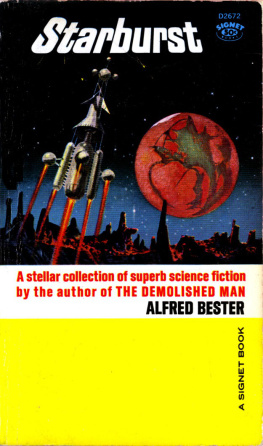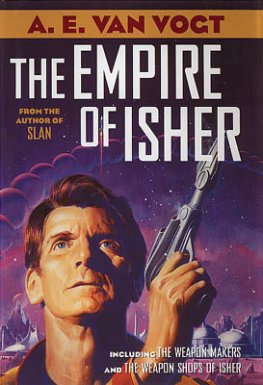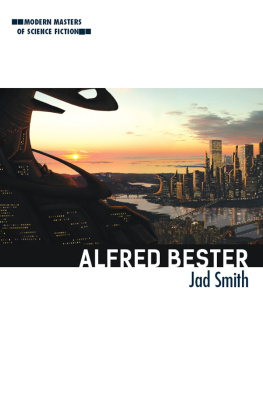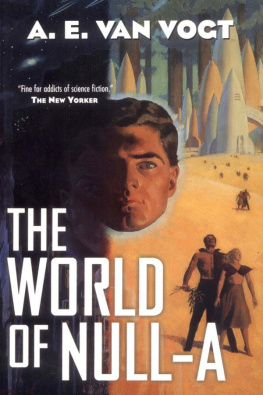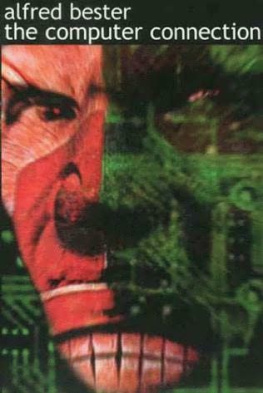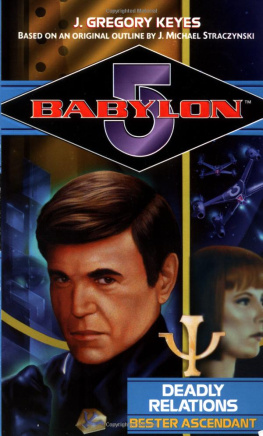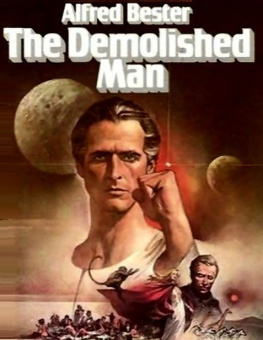Alfred Bester [Bester - Starburst
Here you can read online Alfred Bester [Bester - Starburst full text of the book (entire story) in english for free. Download pdf and epub, get meaning, cover and reviews about this ebook. year: 2012, genre: Humor. Description of the work, (preface) as well as reviews are available. Best literature library LitArk.com created for fans of good reading and offers a wide selection of genres:
Romance novel
Science fiction
Adventure
Detective
Science
History
Home and family
Prose
Art
Politics
Computer
Non-fiction
Religion
Business
Children
Humor
Choose a favorite category and find really read worthwhile books. Enjoy immersion in the world of imagination, feel the emotions of the characters or learn something new for yourself, make an fascinating discovery.
- Book:Starburst
- Author:
- Genre:
- Year:2012
- Rating:3 / 5
- Favourites:Add to favourites
- Your mark:
- 60
- 1
- 2
- 3
- 4
- 5
Starburst: summary, description and annotation
We offer to read an annotation, description, summary or preface (depends on what the author of the book "Starburst" wrote himself). If you haven't found the necessary information about the book — write in the comments, we will try to find it.
Alfred Bester [Bester: author's other books
Who wrote Starburst? Find out the surname, the name of the author of the book and a list of all author's works by series.
Starburst — read online for free the complete book (whole text) full work
Below is the text of the book, divided by pages. System saving the place of the last page read, allows you to conveniently read the book "Starburst" online for free, without having to search again every time where you left off. Put a bookmark, and you can go to the page where you finished reading at any time.
Font size:
Interval:
Bookmark:
STARBURST
by
alfred bester
1958 by Alfred Bester
Disappearing Act, copyright, 1953, by Ballantine Books, Inc., reprinted from Star Science Fiction Stories, No. Adam and No Eve, 1941 by Street and Smith Publications, Inc.; Oddy and Id, 1950 by Street and Smith Publications, Inc., under the title, The Devil's Invention; both reprinted from Astounding Science Fiction. The Roller Coaster, copyright, 1953, by Ziff-Davis Publishing Co., reprinted from Fantastic. Of Time and Third Avenue, 1951 by Mercury Press, Inc. (formerly Fantasy House, Inc.); Hobson's Choice, 1952 by Mercury Press, Inc. (formerly Fantasy House, Inc.); Star Light, Star Bright, 1953 by Mercury Press, Inc. (formerly Fantasy House, Inc.); Fondly Fahrenheit, 1954 by Mercury Press, Inc. (formerly Fantasy House, Inc.); The Starcomber, 1954 by Mercury Press, Inc. (formerly Fantasy House, Inc.) under the title, 5271,009; all reprinted by permission of The Magazine of Fantasy and Science Fiction.
To
ANTHONY BOUCHER
and
J. FRANCIS McCOMAS
This one wasn't the last war or a war to end war. They called it the War for the American Dream. General Carpenter struck that note and sounded it constantly.
There are fighting generals (vital to an army), political generals (vital to an administration), and public relations generals (vital to a war). General Carpenter was a master of public relations. Forthright and Four-Square, he had ideals as high and as understandable as the mottoes on money. In the mind of America he was the army, the administration, the nation's shield and sword and stout right arm. His ideal was the American Dream.
"We are not fighting for money, for power, or for world domination," General Carpenter announced at the Press Association dinner.
"We are fighting solely for the American dream," he said to the 162nd Congress.
"Our aim is not aggression or the reduction of nations to slavery," he said at the West Point Annual Officer's Dinner.
"We are fighting for the Meaning of civilization," he told the San Francisco Pioneers' Club.
"We are struggling for the Ideal of civilization; for Culture, for Poetry, for the Only Things Worth Preserving," he said at the Chicago Wheat Pit Festival.
"This is a war for survival," he said. "We are not fighting for ourselves, but for our Dreams; for the Better Things in Life which must not disappear from the face of the earth."
America fought. General Carpenter asked for one hundred million men. The army was given one hundred million men. General Carpenter asked for ten thousand U-Bombs. Ten thousand U-Bombs were delivered and dropped. The enemy also dropped ten thousand U-Bombs and destroyed most of America's cities.
"We must dig in against the hordes of barbarism," General Carpenter said. "Give me a thousand engineers."
One thousand engineers were forthcoming, and a hundred cities were dug and hollowed out beneath the rubble.
"Give me five hundred sanitation experts, eight hundred traffic managers, two hundred air-conditioning experts, one hundred city managers, one thousand communication chiefs, seven hundred personnel experts..."
The list of General Carpenter's demand for technical experts was endless. America did not know how to supply them.
"We must become a nation of experts," General Carpenter informed the National Association of American Universities. "Every man and woman must be a specific tool for a specific job, hardened and sharpened by your training and education to win the fight for the American Dream."
"Our Dream," General Carpenter said at the Wall Street Bond Drive Breakfast, "is at one with the gentle Greeks of Athens, with the noble Romans of... er... Rome. It is a dream of the Better Things in Life. Of Music and Art and Poetry and Culture. Money is only a weapon to be used in the fight for this dream. Ambition is only a ladder to climb to this dream. Ability is only a tool to shape this dream."
Wall Street applauded. General Carpenter asked for one hundred and fifty billion dollars, fifteen hundred dedicated dollar-a-year men, three thousand experts in mineralogy, petrology, mass production, chemical warfare and air-traffic time study. They were delivered. The country was in high gear. General Carpenter had only to press a button and an expert would be delivered.
In March of A.D. 2112 the war came to a climax and the American Dream was resolved, not on any one of the seven fronts where millions of men were locked in bitter combat, not in any of the staff headquarters or any of the capitals of the warring nations, not in any of the production centers spewing forth arms and supplies, but in Ward T of the United States Army Hospital buried three hundred feet below what had once been St. Albans, New York.
Ward T was something of a mystery at St. Albans. Like all army hospitals, St. Albans was organized with specific wards reserved for specific injuries. Right arm amputees were gathered in one ward; left arm amputees in another. Radiation burns, head injuries, eviscerations, secondary gamma poisonings and so on were each assigned their specific location in the hospital organization. The Army Medical Corps had established nineteen classes of combat injury which included every possible kind of damage to brain and tissue. These used up letters A to S. What, then, was in Ward T?
No one knew. The doors were double locked. No visitors were permitted to enter. No patients were permitted to leave. Physicians were seen to arrive and depart. Their perplexed expressions stimulated the wildest speculations but revealed nothing. The nurses who ministered to Ward T were questioned eagerly but they were close-mouthed.
There were dribs and drabs of information, unsatisfying and self-contradictory. A charwoman asserted that she had been in to clean up and there had been no one in the ward. Absolutely no one. Just two dozen beds and nothing else. Had the beds been slept in? Yes. They were rumpled, some of them. Were there signs of the ward being in use? Oh yes. Personal things on the tables and so on. But dusty, kind of. Like they hadn't been used in a long time.
Public opinion decided it was a ghost ward. For spooks only.
But a night orderly reported passing the locked ward and hearing singing from within. What kind of singing? Foreign language, like. What language? The orderly couldn't say. Some of the words sounded like... well, like: Cow dee on us eager tour...
Public opinion started to run a fever and decided it was an alien ward. For spies only.
St. Albans enlisted the help of the kitchen staff and checked the food trays. Twenty-four trays went into Ward T three times a day. Twenty-four came out. Sometimes the returning trays were emptied. Most times they were untouched.
Public opinion built up pressure and decided that Ward T was a racket. It was an informal club for goldbricks and staff grafters who caroused within. Cow dee on us eager tour indeed!
For gossip, a hospital can put a small town sewing circle to shame with ease, but sick people are easily goaded into passion by trivia. It took just three months for idle speculation to turn into downright fury. In January, 2112, St. Albans was a sound, well-run hospital. By March, 2112, St. Albans was in a ferment, and the psychological unrest found its way into the official records. The percentage of recoveries fell off. Malingering set in. Petty infractions increased. Mutinies flared. There was a staff shake-up. It did no good. Ward T was inciting the patients to riot. There was another shake-up, and another, and still the unrest fumed.
The news finally reached General Carpenter's desk through official channels.
"In our fight for the American Dream," he said, "we must not ignore those who have already given of themselves. Send me a Hospital Administration expert."
Font size:
Interval:
Bookmark:
Similar books «Starburst»
Look at similar books to Starburst. We have selected literature similar in name and meaning in the hope of providing readers with more options to find new, interesting, not yet read works.
Discussion, reviews of the book Starburst and just readers' own opinions. Leave your comments, write what you think about the work, its meaning or the main characters. Specify what exactly you liked and what you didn't like, and why you think so.

